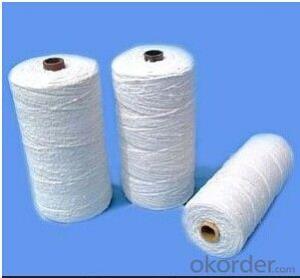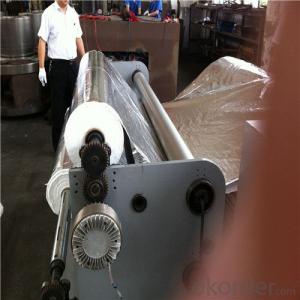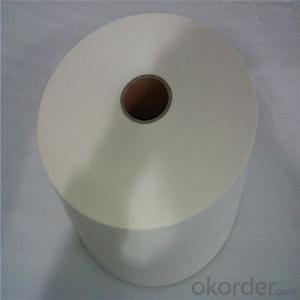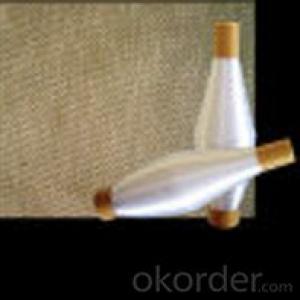Glass Fiber Textiles Cryogenic Insulation Paper for Liquid Oxygen / Nitrogen / LNG
- Loading Port:
- Shanghai
- Payment Terms:
- TT or LC
- Min Order Qty:
- 200 m²
- Supply Capability:
- 10000000 m²/month
OKorder Service Pledge
OKorder Financial Service
You Might Also Like
What is Cryogenic Insulation Paper?
The cryogenic fiberglass insulation paper is fabricated with selected superfine fiberglass which is generally laminated with aluminum foil.
It shares the advantage of low thermal conductivity but high thermal contact resistance, outstanding uniformity, fast outgassing rate but low gas emission under vacuum conditions, light gram-weight and wide applicable working temperature range (-269℃~500℃).
Application of Cryogenic Insulation Paper
Cryogenic liquid storage & mobile containers and pipeline systems for liquid oxygen, nitrogen,hydrogen,helium,argon,LNG and etc.Cryogenic liquid storage & mobile containers and pipeline systems for liquid oxygen, nitrogen, hydrogen, helium, argon, LNG and etc.
Standard size of Cryogenic Insulation Paper
90mm(W) * 1500m(L)
90mm(W) * 167m(L)
Customized size is accepted based on the quantity
Advantages of Cryogenic Insulation Paper
- Low thermal conductivity
- High thermal contact resistance
- Fast outgassing rate but low gas emission under vacuum conditions
- Light gram-weight
- Wide applicable working temperature range (-269℃~500℃)
Data Sheet of Cryogenic Insulation Paper
Item | Unit | Aluminum Foil | Fiberglass Paper |
Thickness | mm | 0.0065 | ≤0.06 |
Bulk Density | g/m2 | 16±2 | 12±2 |
Tensile Strength | Kn/m | / | ≥0.03 |
Harmful Elements | % | Pb<0.01cd<0.01As<0.01 | No |
Width | mm | 40-2400 | 40-2400 |
Thermal Conductivity | w/mk | <0.00015 | |
Photo of Cryogenic Insulation Paper



- Q: Can glass fiber textile be used in aerospace structures?
- Yes, glass fiber textile can be used in aerospace structures. It offers high strength-to-weight ratio, good resistance to heat and chemicals, and excellent electrical insulation properties, making it suitable for various applications in aerospace engineering such as fuselage components, wing structures, and interior panels.
- Q: How do glass fiber textiles perform in terms of flexibility?
- Glass fiber textiles possess exceptional flexibility, a quality attributed to the thin and lightweight nature of glass fibers. As a result, these textiles can be easily manipulated through bending, twisting, or folding, all while maintaining their original form and structural integrity. This remarkable flexibility allows for their wide range of applications and adaptability. They can seamlessly integrate into composite materials, like laminates, to enhance both flexibility and mechanical properties. Moreover, glass fiber textiles exhibit remarkable resilience, enabling them to endure repeated bending or stretching without fracturing or losing their original shape. This outstanding feature makes them highly suitable for industries that prioritize flexibility, such as aerospace, automotive, and sports. In summary, glass fiber textiles provide a superior level of flexibility, making them the favored choice for numerous applications.
- Q: Can glass fiber textiles be used in extreme temperatures?
- Yes, glass fiber textiles can be used in extreme temperatures. Glass fiber is known for its high temperature resistance, making it suitable for use in various industries and applications that require materials to withstand extreme heat. Glass fiber textiles can typically withstand temperatures as high as 1000°C (1832°F) without losing their structural integrity or performance. This makes them ideal for use in applications such as insulation, fireproofing, and protective clothing in environments with high temperatures. Additionally, glass fiber textiles have excellent thermal insulation properties, which further enhances their ability to withstand extreme temperatures.
- Q: Are glass fiber textiles resistant to abrasion?
- Yes, glass fiber textiles are generally resistant to abrasion due to their strong and durable nature.
- Q: Can glass fiber textiles be used in reinforcement composites?
- Glass fiber textiles have the capability to be utilized in reinforcement composites. Renowned for their exceptional strength and stiffness, glass fibers are a favored choice for reinforcing materials in composites. By weaving or knitting glass fibers into a fabric, glass fiber textiles offer additional advantages such as flexibility, easy handling, and enhanced impact resistance. These textiles can be embedded within a matrix material, like resin or polymer, to form a reinforced composite structure. The inclusion of glass fiber textiles aids in the distribution of the load across the entire composite, ultimately elevating its strength and durability. Their widespread application encompasses industries such as automotive, aerospace, construction, and sports equipment manufacturing.
- Q: Can glass fiber textile be used in automotive exteriors?
- Yes, glass fiber textile can be used in automotive exteriors. Glass fiber textile, also known as fiberglass, is a versatile material that is commonly used in various industries including automotive. It offers several advantages such as high strength, lightweight, corrosion resistance, and thermal insulation properties. These qualities make it suitable for use in automotive exteriors. Glass fiber textile can be used to reinforce composite materials used in automotive exteriors, such as body panels, hoods, roofs, and bumpers. By incorporating fiberglass into these components, manufacturers can enhance their structural integrity and durability. The high strength-to-weight ratio of fiberglass also helps reduce the overall weight of the vehicle, leading to improved fuel efficiency and performance. Additionally, glass fiber textiles can be molded into complex shapes, allowing for greater design flexibility. This enables automotive designers to create sleek and aerodynamic exteriors while maintaining the required strength and safety standards. Furthermore, fiberglass is resistant to corrosion, which is particularly beneficial for automotive exteriors that are exposed to various weather conditions, road debris, and chemicals. It also provides thermal insulation, reducing heat transfer and enhancing the overall comfort of the vehicle. In conclusion, glass fiber textile can indeed be used in automotive exteriors due to its strength, lightweight nature, corrosion resistance, thermal insulation properties, and design flexibility. Its utilization in composite materials for body panels, hoods, roofs, and bumpers offer numerous benefits such as improved structural integrity, reduced weight, enhanced fuel efficiency, and resistance to corrosion.
- Q: Are glass fiber textiles resistant to staining?
- Yes, glass fiber textiles are resistant to staining due to their non-absorbent and smooth surface, making them highly resistant to the penetration of liquids and stains.
- Q: What are the ingredients of glass and plastics?
- The glass was originally solidified by acid lava ejected from the volcano. About 3700 BC ago, the ancient Egyptians had made glass ornaments and simple glass ware, only colored glass, about 1000 BC, China made colorless glass. In twelfth Century ad, commercial glass appeared and began to become industrial materials. In eighteenth Century, optical glass was fabricated in order to meet the needs of developing telescopes. In 1873, Belgium first produced flat glass. In 1906, flat glass was produced in the United states. Since then, with the industrialization and large-scale production of glass, various uses and various properties of glass have come out. In modern times, glass has become an important material in daily life, production and science and technology.
- Q: Can glass fiber textile be used in tents and awnings?
- Yes, glass fiber textile can be used in tents and awnings.
- Q: Can glass fiber textiles be used in 3D printing?
- Yes, glass fiber textiles can be used in 3D printing. Glass fiber reinforced materials are commonly used in additive manufacturing processes to enhance the mechanical properties of the printed objects. The addition of glass fiber textiles to the printing material can increase the strength, stiffness, and heat resistance of the printed parts. This makes them suitable for applications that require high strength and durability, such as automotive parts, aerospace components, and industrial machinery. However, it is important to note that using glass fiber textiles in 3D printing may require special modifications to the printing process, such as using larger nozzles and adjusting the printing parameters to accommodate the fibers.
Send your message to us
Glass Fiber Textiles Cryogenic Insulation Paper for Liquid Oxygen / Nitrogen / LNG
- Loading Port:
- Shanghai
- Payment Terms:
- TT or LC
- Min Order Qty:
- 200 m²
- Supply Capability:
- 10000000 m²/month
OKorder Service Pledge
OKorder Financial Service
Similar products
Hot products
Hot Searches
Related keywords


























